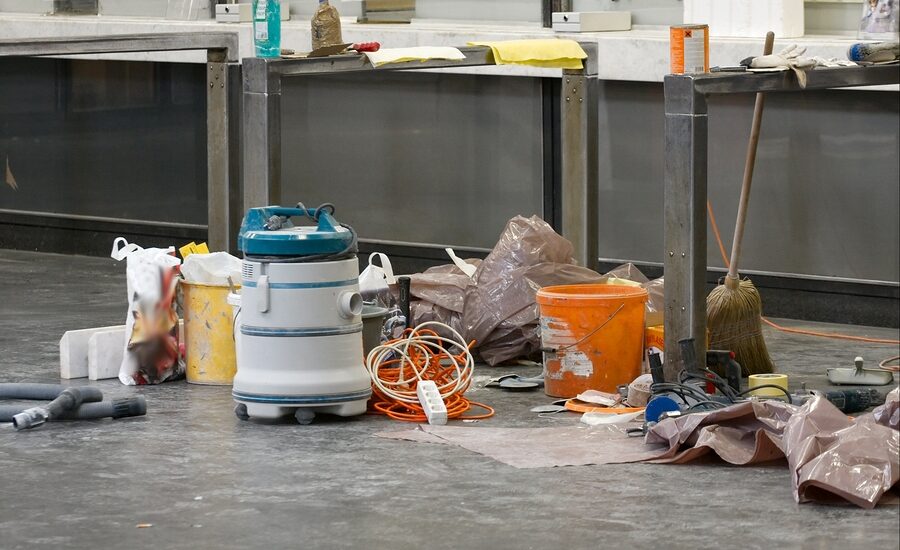- April 20, 2022
- Posted by: admin
- Category: Cleaning

Construction cleaners can quickly turn a messy work site into a safe and clean environment. The process of construction cleaning is much more complicated than a typical cleaning job due to the nature of the materials being removed from the work site and the amount of debris found on the average work site. There will often be construction dust, stickers, glue residue, building scraps and paint overspray that the cleaners must deal with.
A wide range of professional cleaning tools and techniques are used to thoroughly clean a construction site. To help you understand this process, this article will describe the techniques that are used by post-construction cleaning crews.
Worksite Inspection and Initial Quote
Some professional construction cleaners will quote a job sight-unseen while others will require an inspection to assess the extent of the job. The size of the worksite, the kinds of materials that need to be removed and the building’s design will determine how long it takes to clean the space.
If the worksite has a high number of potentially toxic construction materials that need to be handled, the job will be more expensive to perform. Some toxic materials like asbestos can only be handled by licensed cleaners and the presence of this material can greatly increase the cost of site cleanup.
Construction cleaning typically requires a wide range of tools including a shop vacuum cleaner, mops and buckets, ladders, extension poles, brooms, plastic putty knife scrapers, toothbrushes, microfiber cloths, rubbish bags, non-toxic cleaning solutions, spray bottles, and solvents for label removal. Construction cleaners must also use safety equipment because of the potentially dangerous materials on a work site.
Rough clean
The rough clean can occur midway through a construction project or towards the end. Debris and dust from the construction process is completely removed from the worksite during this stage. Other cleaning tasks which may be performed during the rough clean include:
- Rubbish is removed from the site
- Dust is removed from around benches, fixtures and fittings
- Paint overspray is removed
- Adhesive residues are removed from windows, doors, and walls
- All windows, sliding glass doors and glass partitions are thoroughly cleaned
- Window frames are cleaned and window tracks vacuumed
- Ventilation systems are cleaned
- Ceilings are dusted
- Light fixtures and fans are dusted and/or washed
- Vacuum cleaning of walls and washing to remove dust, smudges, dirt, and scuff marks
- Handrails, electrical switches and mantels are dusted and wiped down
- Clean the trim and baseboards
- Exterior clean of debris from gardens
- Power wash of exterior walls
- Floor is vacuumed and washed. Hard floors may be waxed, polished, and/or buffed
The tasks undertaken during a rough clean will vary according to how much of the construction project has been completed and which jobs remain. For example, if the painters are yet to come through, the cleaners will only dust the walls and ignore minor smudges. In many cases, the main focus of a rough clean is to remove any substances that may be dangerous or interfere with the ability of contractors to get their job done.
Final Clean
The final clean occurs shortly after the construction project has been completed. It typically consists of every step in the rough clean phase. The building is very thoroughly and comprehensively cleaned during this stage — cleaners will carefully remove minor blemishes like smudges and fingerprints. Floors will often receive their final finish at this stage. After the final clean has been performed, the space is considered ready to move into.
Touch-Up Clean
A few weeks after the final clean, dust may have settled in the property and an additional clean-through is required. This stage of cleaning is similar to a basic household cleaning routine. Dust is removed from the space and the cleaners will once-again clean windows, walls, ceilings and floors. The property owner can now enjoy a clean and hygienic space!
Sources
Potential Chemicals Found in Building Materials. (2016). Nchh.org. Retrieved 30 July 2016, from http://www.nchh.org/Resources/Building-Materials-and-Products/Potential-Chemicals-Found-in-Building-Materials.aspx
Personal Protective Equipment. (2016). Osha.gov. Retrieved 30 July 2016, from https://www.osha.gov/Publications/
